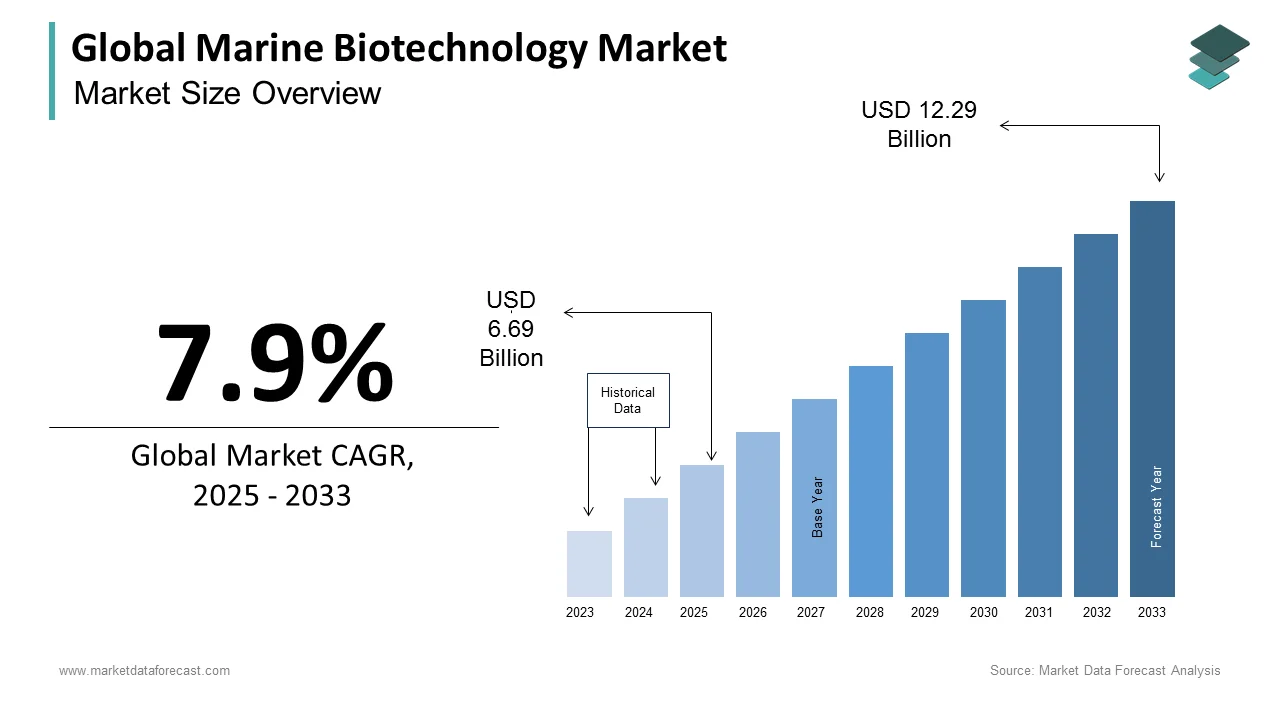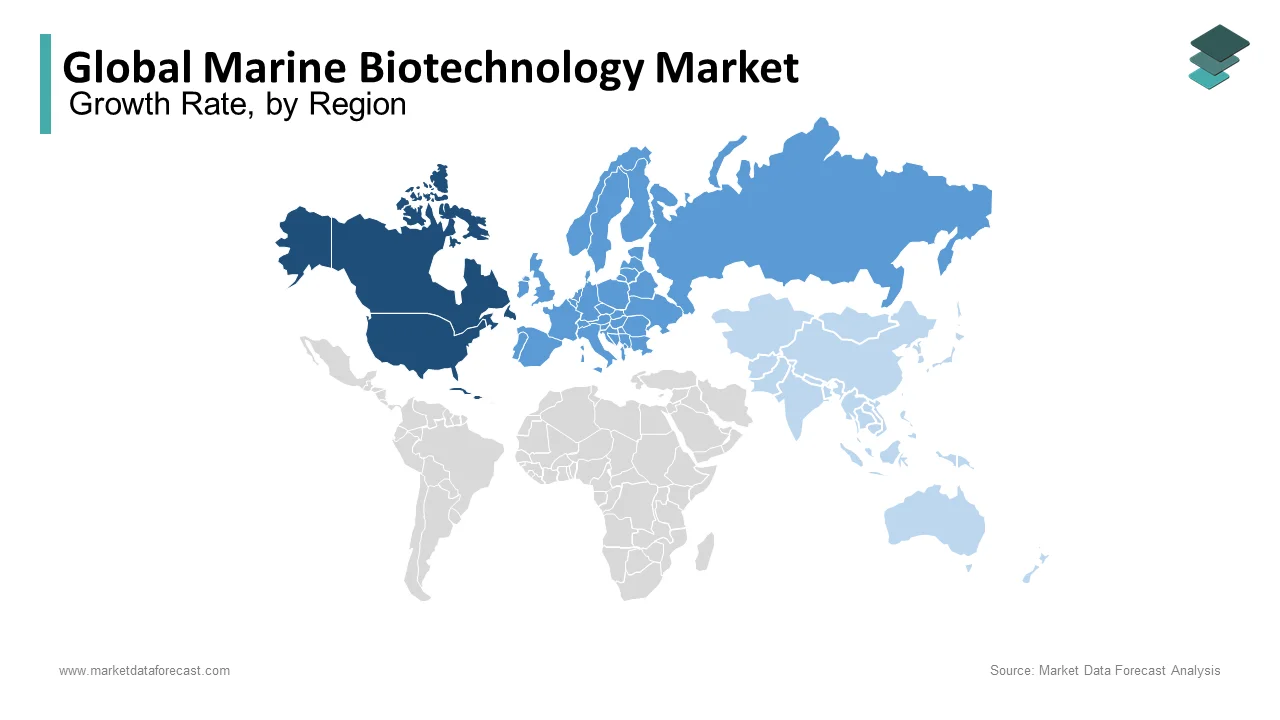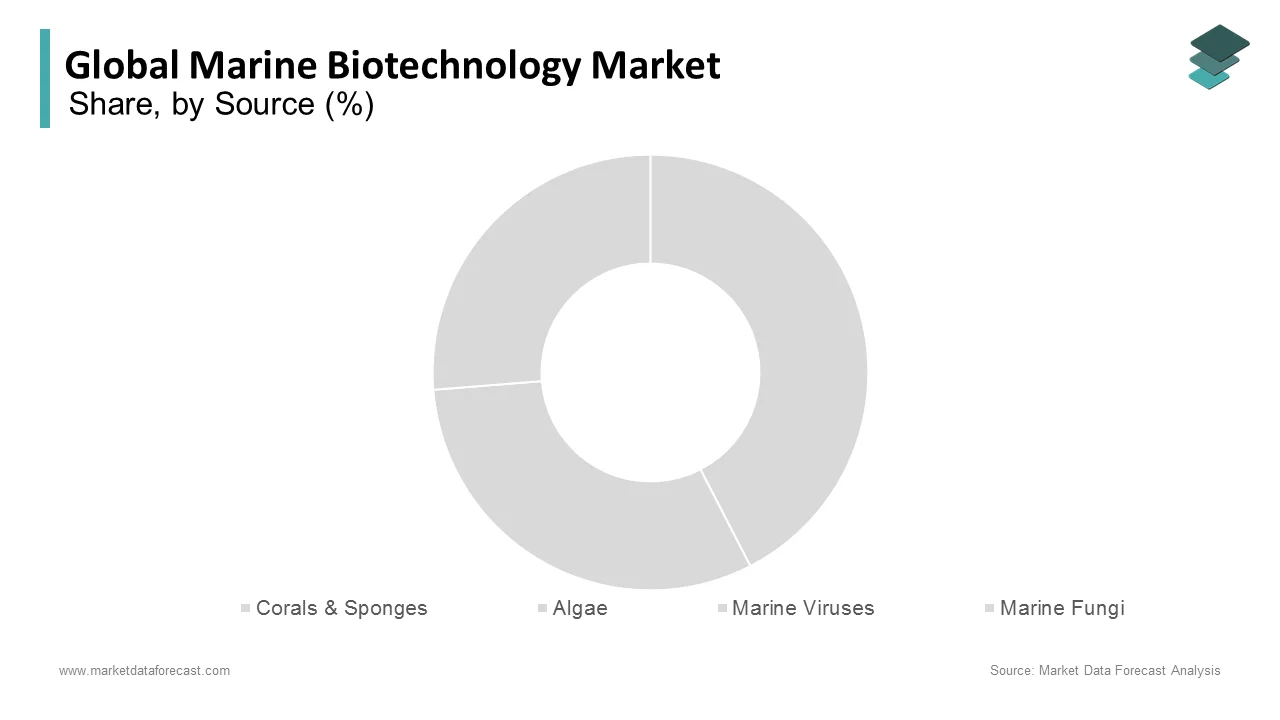Global Marine Biotechnology Market Size, Share, Trends & Growth Forecast Report By Source (Corals & Sponges, Algae, Marine Viruses, Marine Fungi, Others), By Application (Aquaculture & Fishery, Medicine, Environment, Biofuels, Others), By End-User (Medical & Pharmaceutical, Food Industry, Chemical Industry, Cosmetic Industry, Others), and Region (North America, Europe, Asia-Pacific, Latin America, Middle East and Africa), Industry Analysis From 2025 to 2033.
Global Marine Biotechnology Market Size
The size of the global marine biotechnology market was worth USD 6.20 billion in 2024. The global market is anticipated to grow at a CAGR of 7.9% from 2025 to 2033 and be worth USD 12.29 billion by 2033 from USD 6.69 billion in 2025.

Marine biotechnology is a dynamic intersection of science and commerce by harnesses the potential of oceanic biodiversity to drive innovation across multiple sectors. It leverages the vast biodiversity of oceans which covers approximately 71% of the Earth's surface and host nearly 2.2 million marine species, according to UNESCO. Marine organisms such as algae, sponges and fungi produce over 20,000 bioactive compounds many of these are utilized in drug discovery, nutraceuticals and cosmetics. Moreover, algae cultivation plays a significant role with 50 million tons of seaweed harvested globally each year, as reported by the Food and Agriculture Organization (FAO). These algae are used in biofuels, food additives and pharmaceuticals. Additionally, marine microbes account for 50% of the Earth's oxygen production that showcases their ecological importance alongside their application in biotechnology.
MARKET DRIVERS
Marine Biomaterials for Healthcare Applications
The revolutionizing healthcare with biomaterials such as chitosan derived from crustacean shells is widely used in wound healing and tissue engineering. According to the U.S. FDA, chitosan-based products have shown significant potential in medical applications due to their biocompatibility and antimicrobial properties. Additionally, marine collagen stemming from fish skin is increasingly used in regenerative medicine and cosmetic procedures. The FAO reports that approximately 6 million tons of fish processing waste are generated annually that provides a sustainable source for these high-value biomaterials.
Environmental Bioremediation
Marine organisms are playing a crucial role in bioremediation efforts and is particularly for oil spill cleanup and wastewater treatment. For example, Algae can absorb heavy metals and degrade hydrocarbons and makes them an effective tool for environmental restoration. According to the United Nations Environment Programme (UNEP), algal bioremediation could treat up to 70% of industrial wastewater in marine-adjacent industries that reduces ecological damage and promoting sustainable resource management. These innovations underscore marine biotechnology's vital role in addressing environmental challenges while supporting economic and ecological sustainability.
MARKET RESTRAINTS
Limited Exploration and Sampling of Marine Resources
A significant restraint in the marine biotechnology market is the lack of exploration with over 80% of the world’s oceans remaining unmapped, as per National Oceanic and Atmospheric Administration (NOAA). This unexplored terrain limits access to potentially groundbreaking organisms with bioactive compounds. High costs associated with deep-sea exploration and advanced technologies such as remotely operated vehicles (ROVs) further restrict sampling activities. Moreover, the harsh marine environment complicates the extraction and transportation of samples create additional financial and logistical barriers and is especially for small-scale enterprises.
Complex Regulatory Frameworks
Stringent regulations surrounding marine resource utilization hinder market growth. The Nagoya Protocol under the Convention on Biological Diversity (CBD) mandates benefit-sharing agreements for genetic resource access generating legal and financial burdens. According to UNEP, compliance costs can range from 10,000 to 100,000 dollars per project is discouraging investment in marine biotechnology. Additionally, overlapping international, regional and national regulations produce ambiguities and delays R&D timelines. Such regulatory challenges disproportionately affect smaller players limits their ability to compete with established firms.
MARKET OPPORTUNITIES
Marine Enzymes for Industrial Applications
Marine-derived enzymes are emerging as a valuable resource for industries due to their ability to function in extreme conditions such as high salinity and temperature. These enzymes are utilized in bioenergy production, food processing and detergents. Marine enzymes, like amylases and proteases from deep-sea microbes, offer sustainable and efficient alternatives by enhancing industrial processes while reducing environmental impact. For instance, marine cellulases and lipases contribute to bioethanol and biodiesel production, with efficiencies improving by 15-20% compared to traditional enzymes. According to Bioenergy Research Journal.
Blue Carbon Ecosystem Utilization
Marine ecosystems like mangroves, seagrasses and algae contribute significantly to carbon sequestration oftenly referred to as "blue carbon." The UNFCCC reports that these ecosystems sequester up to 10 billion tons of CO₂ annually offer opportunities for biotechnology solutions in carbon credits and climate mitigation projects. Advancing this biotech to enhance blue carbon sequestration efficiency not only addresses climate goals but also makes a lucrative market for eco-friendly technologies. Governments and organizations are increasingly investing in marine-based carbon management and thereby positioning this as a high-potential area for growth.
MARKET CHALLENGES
High Costs of Scaling Marine Biotechnology
The initial research shows promise and scaling lab discoveries to industrial applications is cost-intensive. According to the OECD, the transition from laboratory-scale to industrial-scale production can increase costs by over 300% due to specialized facilities, equipment and stringent safety measures. This financial burden limits accessibility for smaller companies and delays commercialization timelines particularly in emerging economies.
Conservation and Resource Sustainability
The overharvesting of marine organisms for biotechnology applications poses risks to biodiversity and ecological balance. The IUCN highlights that nearly 33% of reef-building corals face extinction threats that is partly due to unsustainable resource extraction. Balancing innovation with conservation efforts is a critical challenge and requires stringent sustainability guidelines and industry compliance to protect marine ecosystems while ensuring long-term resource availability.
REPORT COVERAGE
|
REPORT METRIC |
DETAILS |
|
Market Size Available |
2024 to 2033 |
|
Base Year |
2024 |
|
Forecast Period |
2024 to 2033 |
|
Segments Covered |
By Source, Application, End-Use, and Region. |
|
Various Analyses Covered |
Global, Regional & Country Level Analysis, Segment-Level Analysis, Drivers, Restraints, Opportunities, Challenges; PESTLE Analysis; Porter's Five Forces Analysis; Competitive Landscape; Analyst Overview of Investment Opportunities |
|
Regions Covered |
North America, Europe, Asia Pacific, Latin America, Middle East & Africa |
|
Market Leaders Profiled |
BASF, CP Kelco, Cyanotech Corp., Kerry Group, TransGen Biotech Co. Ltd., Olmix Group, Ittinsect, Biotech Marine, Corbion, FMC Corporation |
SEGMENTAL ANALYSIS
By Source Insights
The algae segment accounted for 33.6% of the global market share in 2024. Algae is highly valued for their diverse applications across industries such as pharmaceuticals, nutraceuticals, cosmetics and biofuels. Additionally, algae's high lipid content positions them as a sustainable feedstock for biofuel production and contributes significantly to renewable energy initiatives. For instance, spirulina and chlorella, two popular algae types that contain 50 to 70% protein by dry weight and high concentrations of vitamin B12, iron, and antioxidants which is making them widely used in dietary supplements. Additionally, algae's high lipid content that ranges from 20–50% in microalgae species and positions them as a sustainable feedstock for biofuel production by contributing significantly to renewable energy initiatives.
On the other hand, the marine fungi segment is projected to grow at a CAGR of 8.5% over the forecast period. Marine fungi produce novel bioactive compounds with antimicrobial and anticancer properties, which are increasingly being explored for therapeutic applications. Marine fungi produce over 1,000 novel bioactive compounds where many of which exhibit antimicrobial and anticancer properties, making them valuable for therapeutic applications, as per the PubMed Central. Furthermore, enzymes derived from marine fungi are being utilized in industrial processes to enhance efficiency and promote sustainability. Together, these factors highlight the significant roles of algae and marine fungi in shaping the future of the marine biotechnology market.
By Application Insights
The medicine segment occupied a share of 32.4% of the global market in 2024. The domination of medicine segment is attributed to the extensive utilization of marine-derived compounds in pharmaceutical applications. The continuous discovery of novel marine-derived compounds underscores the Medicine segment's significance with over 14,000 marine samples screened by Indian researchers, identifying 18 promising drug leads for diseases such as diabetes, tuberculosis, and cancer, according to the Press Information Bureau, Government of India. For instance, certain marine algae species produce bioactive metabolites with antiviral and immunomodulatory activities which have been explored for their potential health benefits. The significance of the Medicine segment is underscored by the continuous discovery of novel marine-derived compounds that contribute to drug development and therapeutic innovations.
Conversely, the biofuels segment is anticipated to witness a CAGR of 10.4% over the forecast period owing to the increasing demand for sustainable and renewable energy sources. Marine biotechnology offers promising solutions through the utilization of marine algae for biofuel production. Algae can be cultivated to produce biofuels, providing an alternative to fossil fuels and contributing to energy security. Companies are expanding their biofuel offerings to meet this rising demand. For instance, KPI OceanConnect plans to extend its biofuel services to 120 ports globally, up from the current 70 in response to the anticipated increase in demand driven by upcoming environmental regulations, as per Reuters.
By End-Use Insights
The medical and pharmaceutical segment had 31.9% of the global market share in 2024. The extensive utilization of bioactive compounds derived from marine organisms such as algae, sponges, and fungi that are critical in developing pharmaceuticals like antibiotics, antivirals, and anticancer agents is propelling the growth of the medical and pharmaceutical segment in the global market. For instance, the FDA-approved drug Trabectedin derived from marine sources is used to treat soft tissue sarcomas. The growing demand for novel therapies to address antimicrobial resistance and rare diseases along with significant funding from institutions like the NIH underscores the importance of this segment. Notably marine-derived or marine-inspired drugs accounted for approximately 14% of newly approved drugs over the last decade highlighting their critical role in advancing global healthcare.
The food segment is predicted to register the highest CAGR of 7.1% over the forecast period. Factors such as the increasing consumer demand for functional foods enriched with marine-derived ingredients such as omega-3 fatty acids, seaweed, and protein-rich algae that offer significant health benefits is driving the growth of the food segment in the global market. Additionally, sustainability trends are driving the adoption of marine-based food products as alternatives to traditional food sources. Countries like Japan and Norway are heavily investing in algae farming, with Japan’s Ministry of Agriculture reporting a 45% growth in edible seaweed exports in 2022. These developments are crucial in addressing global malnutrition, as nearly 2 billion people face micronutrient deficiencies, according to the UN FAO. The growing emphasis on health-conscious and sustainable dietary choices positions the Food Industry segment as a key driver of growth in the marine biotechnology market.
REGIONAL ANALYSIS
North America captured 28.7% of the global marine biotechnology market share in 2024 and is poised for steady CAGR of 6.8% during the forecast period. It is a key region in marine biotechnology by leveraging its extensive coastline and biodiversity. The United States leads the region with research backed by agencies such as the National Oceanic and Atmospheric Administration (NOAA) which manages 13 national marine sanctuaries across 600,000 square miles of ocean and Great Lakes waters. The U.S. also ranks among the top 5 nations in marine biodiversity research publications globally. Moreover, Canada contributes with its robust aquaculture industry by producing more than 200,000 metric tons of seafood annually and much of which is underpinned by marine biotechnology for sustainability.

Europe is predicted to maintain robust growth over the forecast period. Europe is leading market as globally in sustainable marine resource utilization with 44% of its coastal areas under marine protected status, as reported by the European Environment Agency (EEA). The region is home to cutting-edge facilities like the Marine Institute in Ireland and the European Marine Biological Resource Centre that drive advancements in pharmaceuticals and biofuels. Norway’s fisheries account for 3 million metric tons of marine product exports often utilizing biotechnological advancements in processing.
The Asia-Pacific region is the fastest-growing regional segment and is estimated to grow at a CAGR of 7.9% over the forecast period owing to its vast marine biodiversity. Japan with its exclusive economic zone (EEZ) spanning over 4.47 million square kilometers invests heavily in algae cultivation for biofuels and functional foods. China also contributes with its large aquaculture industry delivering over 60 million metric tons of seafood annually and is highest globally. South Korea’s government-funded Korea Research Institute of Ships and Ocean Engineering (KRISO), which is a global leader in marine biomaterial research.
Latin America is growing at steady pace and is expected to showcase a CAGR of 6.4% over the forecast period. Countries like Brazil and Chile possess rich marine ecosystems including nearly 25% of the world's coral reefs in Brazil and a vast seaweed farming industry in Chile which is producing over 9,000 metric tons annually. These ecosystems are a foundation for advancements in pharmaceuticals and nutraceuticals.
The market in Middle East and Africa is anticipated to grow at a moderate CAGR over the forecast period. The region despite being smaller in market size is home to unique marine ecosystems like the Red Sea which has over 200 species of corals and 1,200 species of fish and many of which are endemic. South Africa is exploring marine biotechnology for pharmaceuticals, while the UAE focuses on algae cultivation for biofuel under its National Energy Strategy 2050.
KEY MARKET PLAYERS
BASF, CP Kelco, Cyanotech Corp., Kerry Group, TransGen Biotech Co. Ltd., Olmix Group, Ittinsect, Biotech Marine, Corbion, FMC Corporation, and Others.
COMPETITIVE LANDSCAPE
The fiercely competitive marine biotechnology market is fueled by advancements in science and rising demand for eco-friendly innovations across various sectors. Prominent entities include global corporations, agile startups and academic institutions all utilize marine ecosystems to create solutions for pharmaceuticals, nutraceuticals, personal care and renewable energy.
Major players like BASF SE, Aker BioMarine, and Cyanotech Corporation lead through substantial R&D spending, strategic alliances, and robust patent portfolios. These organizations emphasize bioactive substances, omega-3 supplements, and algae-derived products are gaining an edge with scale efficiencies and extensive supply chains. Concurrently, emerging businesses and smaller enterprises drive creativity by focusing on specialized offerings including bioplastics from marine byproducts and tailored nutritional additives.
Regional competitors intensify the landscape by leveraging geographic advantages. European firms benefit from EU initiatives like Horizon Europe, while Asia-Pacific companies exploit diverse marine resources and cost-effective production processes to innovate and expand.
Strong collaboration between universities and businesses accelerates breakthroughs enables access to advanced studies and unique marine organisms. Furthermore, heightened regulatory emphasis on environmental responsibility and conservation presents both opportunities and obstacles compells participants to innovate responsibly. The industry remains vibrant propelled by technological progress, local strengths, and a rising preference for sustainable and ethical practices.
RECENT HAPPENINGS IN THE MARKET
- In October 2024, marine fuel trading company KPI OceanConnect announced plans to expand its biofuel offerings to 120 ports worldwide, up from the current 70. This expansion aims to meet the rising demand for sustainable marine fuels, driven by upcoming regulatory changes.
- In August 2024, Woodside Energy announced the acquisition of a low-carbon ammonia production facility in Texas from OCI Global for $2.35 billion. This facility, under construction at the time, was expected to commence ammonia production in 2025, with plans to integrate carbon capture and storage technologies by 2026. The investment aligns with Woodside's strategy to expand its footprint in low-emission fuels, recognizing ammonia's potential in power generation, marine fuels, and as a hydrogen carrier.
MARKET SEGMENTATION
This research report on the Global Spatial Omics Market has been segmented and sub-segmented based on source, application, end-use, and region.
By Source
- Corals & Sponges
- Algae
- Marine Viruses
- Marine Fungi
- Others
By Application
- Aquaculture & Fishery
- Biofuels
- Medicine
- Environment
- Others
By End-Use
- Medical & Pharmaceutical Industry
- Chemical Industry
- Food Industry
- Cosmetic Industry
By Region
- North America
- Europe
- Asia Pacific
- Latin America
- Middle East and Africa
Frequently Asked Questions
What are the key drivers of the Marine Biotechnology market?
The market is primarily driven by increasing demand for marine-derived products in pharmaceuticals, cosmetics, and agriculture. Additionally, the growing awareness of the potential of marine resources for biotechnological applications is contributing to market growth.
What are the challenges faced by the Marine Biotechnology industry?
Challenges include limited knowledge about marine organisms, ethical concerns related to biodiversity conservation, and the high costs associated with marine biotechnology research and development.
Which regions are emerging as key players in the Marine Biotechnology market?
Coastal regions with strong research infrastructure, such as North America, Europe, and parts of Asia-Pacific, are emerging as key players. However, collaboration and partnerships are common across borders in this global industry.
Related Reports
Access the study in MULTIPLE FORMATS
Purchase options starting from $ 2500
Didn’t find what you’re looking for?
TALK TO OUR ANALYST TEAM
Need something within your budget?
NO WORRIES! WE GOT YOU COVERED!
Call us on: +1 888 702 9696 (U.S Toll Free)
Write to us: [email protected]

